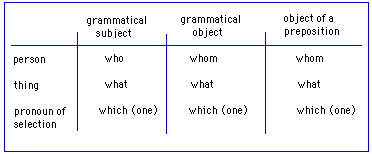

Simple questions
Simple questions (that is, questions to which one can respond by a simple "yes" or "no") may be formed in three different ways:
1. "Do": one precedes an assertion with "do" or "does" (or "don't" or "doesn't" for a negative expression, or "did", "didn't" for the past):
But: One never places "do" or "does" before the verb "to be" or before modal verbs in questions; in this case it is preferable to invert the subject and verb:
2. Inversion: with certain verbs (especially the verbs "to be", "to do", "to have", and modal verbs) questions are formed by inverting the subject and object. (In the case of the verb "to have," which is usually combined with "do" in interrogatives, inversion signals a literary style.)
3. Modal phrases: If a modal verb is used in a sentence, or if it is strongly implied, a modal phrase can be used to make an interrogative form. The modal phrase is typically an inversion of the subject and verb, in the negative, repeated at the end of the sentence:
In the case of a negative question, the modal phrase would be in the affirmative:
(See also: negations)
Simple questions solicit a "yes" or "no" answer. More precise questions may be formed by using the interrogative adverbs: when, why, how, how much, where. Generally, the interrogative adverb precedes the rest of the question; then the order of the sentence follows the rules indicated for inversion or for questions formed with "do / does".
See also: Questions, Interrogative pronouns.
Interrogative pronouns are used to ask who has done what, to whom, why, with what, etc. Normally these pronouns are placed at the beginning of the sentence; hen the order of the sentence follows the rules indicated for inversion or for questions formed with "do / does".
One chooses the pronoun based on its function, according to the following table:

subject (person) : who + question
subject (thing) : what + question
direct object (person) : whom + question
direct objet (thing) : what + question
object of a preposition (person) : preposition + whom + question
Note: In spoken English, one often places the preposition at the end of the sentence, in which case one uses "who" instead of "whom"
object of a preposition (thing) : preposition + what + question
Note: In spoken English, the preposition is often put at the end of the sentence:
The adjective "which" and its pronominal forms ("which", "which one", "which ones") ask that a person make a choice. Usually these pronouns will be placed at the beginning of the sentence; Normalement, ces pronoms se trouveront au début de la phrase ; then the order of the sentence follows the rules indicated for inversion or for questions formed with "do / does".